Jhelum River
| Jhelum | |
|---|---|
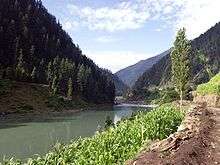 Jhelum River during the summer | |
 Flow of Jhelum. | |
| Native name |
ਜਿਹਲਮ ਦਰਿਆ (Punjabi) झेलम (Devanāgarī) |
| Country | India, Pakistan |
| Basin | |
| Main source | Verinag Spring |
| River mouth | Chenab River |
| Physical characteristics | |
| Length | 725 km (450 mi) |
| Discharge |
|
| Features | |
| Tributaries |
|
Jehlam River or Jhelum River (/ˈdʒeɪləm/) is a river that flows in Indian and Pakistani Kashmir, and Punjab, Pakistan. It is the westernmost of the five rivers of Punjab, and passes through Jhelum District. It is a tributary of the Chenab River and has a total length of about 725 kilometres (450 mi).[1]
Etymology

The Sanskrit name of this river is Vitasta. The river got this name from the incident regarding the origin of the river as explained in Nilamata Purana. Goddess Parvati was requested by sage Kasyapa to come to Kashmir for purification of the land from evil practices and impurities of Pisachas living there. Goddess Parvati then assumed the form of a river in the Nether World. Then Lord Shiva made a stroke with his spear near the abode of Nila (Verinag Spring). By that stroke of the spear, Goddess Parvati came out of the Nether World. Shiva himself named her as Vitasta. He had excavated with the spear a ditch measuring one Vitasti(a particular measure of length defined either as a long span between the extended thumb and little finger, or as the distance between the wrist and the tip of the fingers, and said to be about 9 inches), through which the river - gone to the Nether World - had come out, so she was given the name Vitasta by him.[2]
History


The river Jhelum is called Vitastā in the Rigveda and Hydaspes by the ancient Greeks. The Vitasta (Sanskrit: वितस्ता, fem., also, Vetastā) is mentioned as one of the major rivers by the holy scriptures — the Rigveda. It has been speculated that the Vitastā must have been one of the seven rivers (sapta-sindhu) mentioned so many times in the Rigveda. The name survives in the Kashmiri name for this river as Vyeth. According to the major religious work Srimad Bhagavatam, the Vitastā is one of the many transcendental rivers flowing through land of Bharata, or ancient India.
The river was regarded as a god by the ancient Greeks, as were most mountains and streams; the poet Nonnus in the Dionysiaca (section 26, line 350) makes the Hydaspes a titan-descended god, the son of the sea-god Thaumas and the cloud-goddess Elektra. He was the brother of Iris, the goddess of the rainbow, and half-brother to the Harpies, the snatching winds. Since the river is in a country foreign to the ancient Greeks, it is not clear whether they named the river after the god, or whether the god Hydaspes was named after the river. Alexander the Great and his army crossed the Jhelum in BC 326 at the Battle of the Hydaspes River where he defeated the Indian king, Porus. According to Arrian (Anabasis, 29), he built a city "on the spot whence he started to cross the river Hydaspes", which he named Bukephala (or Bucephala) to honour his famous horse Bukephalus or Bucephalus which was buried in Jalalpur Sharif. It is thought that ancient Bukephala was near the site of modern Jhelum City. According to a historian of Gujrat district, Mansoor Behzad Butt, Bukephalus was buried in Jalalpur Sharif, but the people of Mandi Bahauddin, a district close to Jehlum, believed that their tehsil Phalia was named after Bucephalus, Alexander's dead horse. They say that the name Phalia was the distortion of the word Bucephala. The waters of the Jhelum are allocated to Pakistan under the terms of the Indus Waters Treaty. India is working on a hydropower project on a tributary of Jhelum river to establish first-use rights on the river water over Pakistan as per the Indus waters Treaty.[3]
Course
The river Jhelum rises from Verinag Spring situated at the foot of the Pir Panjal in the south-eastern part of the valley of Kashmir. It flows through Srinagar and the Wular lake before entering Pakistan through a deep narrow gorge. The Neelum River, the largest tributary of the Jhelum, joins it, at Domel Muzaffarabad, as does the next largest, the Kunhar River of the Kaghan valley. It also connects with rest of Pakistan and Pakistani Kashmir on Kohala Bridge east of Circle Bakote. It is then joined by the Poonch river, and flows into the Mangla Dam reservoir in the district of Mirpur. The Jhelum enters the Punjab in the Jhelum District. From there, it flows through the plains of Pakistan's Punjab, forming the boundary between the Chaj and Sindh Sagar Doabs. It ends in a confluence with the Chenab at Trimmu in District Jhang. The Chenab merges with the Sutlej to form the Panjnad River which joins the Indus River at Mithankot.
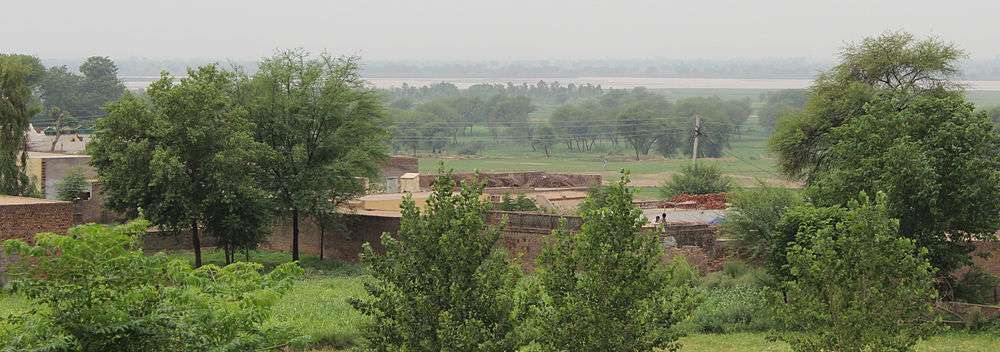
Dams and barrages
Water control structures are being built as a result of the Indus Basin Project, including the following:
- Mangla Dam, completed in 1967, is one of the largest earthfill dams in the world, with a storage capacity of 5,900,000 acre feet (7.3 km3)
- Rasul Barrage, constructed in 1967, has a maximum flow of 850,000 ft³/s (24,000 m³/s).
- Trimmu Barrage, constructed in 1939 some 90 km from Mari Shah Sakhira town, at the confluence with the Chenab, has maximum discharge capacity of 645,000 ft³/s (18,000 m³/s).
- Haranpur (Victoria Bridge) Constructed in 1933 Approximate 5 km from Malakwal near Chak Nizam Village. Its length is 1 km mainly used by Pakistan Railways but there is a passage for light vehicles, motorcycles, cycles and pedestrians at one side.
Canals
- The Upper Jhelum Canal runs from Mangla Dam to the Chenab.
- The Rasul-Qadirabad Link Canal runs from the Rasul Barrage to the Chenab.
- The Chashma-Jhelum Link Canal runs from the Chashma Barrage on the Indus River to the Jhelum river downstream of Rasul Barrage. This is 40 kilometres (25 mi) from Mari Shah Sakhira town.
Gallery
-
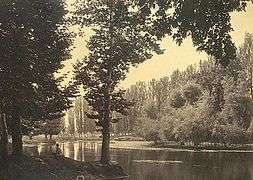
View on the river at Srinagar, Jammu and Kashmir
-

Jhelum River near Bele BBQ
-

Jhelum River in Azad Kashmir, Pakistan
-

Jhelum River c. 1900; photo taken by Eugene Whitehead Esq.
-

A Hindu "Fakir" on the Banks of the Jhelum, ca. 1905
-

Rope Bridge at Karli, Kashmir (1908)
-
.jpg)
Jhelum River at Uri Kashmir (1903)
-
Jhelum river,Baramullah,Kashmir,(1880s)
-
Jhelum River at Jhelum City (2015)
-
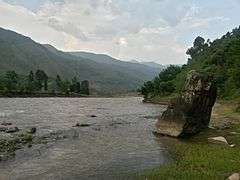
Jehlum River Muzaffarabad best view (2014)
-
File:River Jehlum, Muzaffarabad
-

Muzaffarabad 2014 (Jehlum River)
-

-
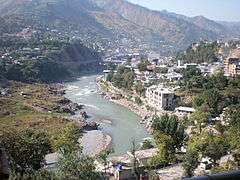
Muzaffarabad (2007)
-
Origin of the Jhelum (2014)
-
Jhalum river water fall at Verinag(2014)
-

Jhelum River near Al-jalal kinara (2009)
-
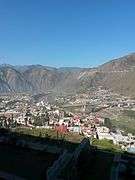
Jehlum River Muzaffarabad(2007
-
Jhelum River at Jhelum City(2005)
References
- ↑ Jhelum River -- Encyclopedia Britannica. Retrieved on 2013-10-04.
- ↑ The Nilamata Purana English Translation by Dr. Ved Kumari verses 247-261
- ↑ "India fast-tracks work on Jhelum river hydroelectric power project". Retrieved 25 May 2010.
External links
| Wikimedia Commons has media related to Jhelum River. |
Coordinates: 31°12′N 72°08′E / 31.200°N 72.133°E
%2C_1969%2C_bridge_over_the_Jelhum_river..jpg)